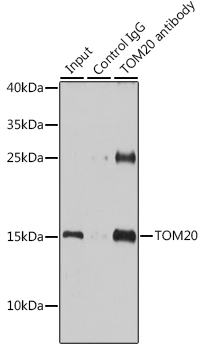TOMM20 antibody
GTX133756
ApplicationsImmunoFluorescence, Western Blot, ImmunoCytoChemistry, ImmunoHistoChemistry, ImmunoHistoChemistry Paraffin
Product group Antibodies
TargetTOMM20
Overview
- SupplierGeneTex
- Product NameTOMM20 antibody
- Delivery Days Customer9
- Application Supplier NoteWB: 1:500-1:3000. IHC-P: 1:100-1:1000. *Optimal dilutions/concentrations should be determined by the researcher.Not tested in other applications.
- ApplicationsImmunoFluorescence, Western Blot, ImmunoCytoChemistry, ImmunoHistoChemistry, ImmunoHistoChemistry Paraffin
- CertificationResearch Use Only
- ClonalityPolyclonal
- Concentration0.21 mg/ml
- ConjugateUnconjugated
- Gene ID9804
- Target nameTOMM20
- Target descriptiontranslocase of outer mitochondrial membrane 20
- Target synonymsMAS20, MOM19, TOM20, mitochondrial import receptor subunit TOM20 homolog, mitochondrial 20 kDa outer membrane protein, outer mitochondrial membrane receptor Tom20, translocase of outer mitochondrial membrane 20 homolog type II
- HostRabbit
- IsotypeIgG
- Protein IDQ15388
- Protein NameMitochondrial import receptor subunit TOM20 homolog
- Scientific DescriptionCentral component of the receptor complex responsible for the recognition and translocation of cytosolically synthesized mitochondrial preproteins. Together with TOM22 functions as the transit peptide receptor at the surface of the mitochondrion outer membrane and facilitates the movement of preproteins into the TOM40 translocation pore.
- Storage Instruction-20°C or -80°C,2°C to 8°C
- UNSPSC12352203
References
- Chen KC, Chen CR, Chen CY, et al. Bicalutamide Exhibits Potential to Damage Kidney via Destroying Complex I and Affecting Mitochondrial Dynamics. J Clin Med. 2021,11(1). doi: 10.3390/jcm11010135Read this paper
- Bosc C, Broin N, Fanjul M, et al. Autophagy regulates fatty acid availability for oxidative phosphorylation through mitochondria-endoplasmic reticulum contact sites. Nat Commun. 2020,11(1):4056. doi: 10.1038/s41467-020-17882-2Read this paper
- Keller G, Binyamin O, Frid K, et al. Mitochondrial dysfunction in preclinical genetic prion disease: A target for preventive treatment? Neurobiol Dis. 2019,124:57-66. doi: 10.1016/j.nbd.2018.11.003Read this paper



![ICC/IF analysis of HeLa cells using GTX00773 TOMM20 antibody [GT1136]. Orange: Primary antibody Blue: DAPI Dlution : 1:100-1:1600](https://www.genetex.com/upload/website/prouct_img/normal/GTX00773/GTX00773_20191101_AP_002_9_w_23053121_571.webp)
